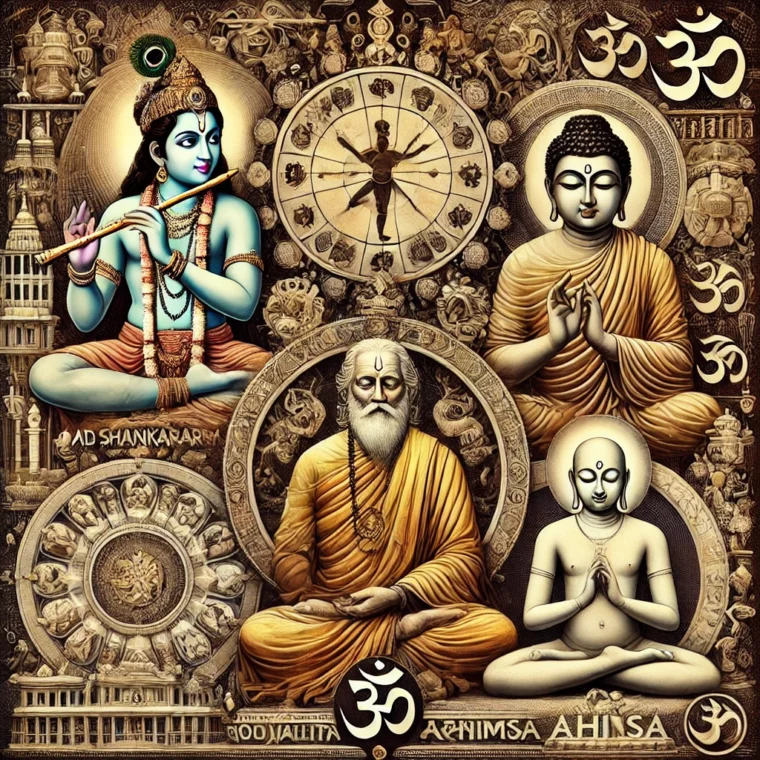Indian philosophy is enriched by a vast array of spiritual teachings, with key figures such as Lord Krishna, Adi Shankaracharya, Gautama Buddha, and Mahavira providing transformative insights into the nature of existence, the soul, and the path to liberation. Though their teachings differ in various aspects, they share common threads that contribute to the profound spiritual heritage of India. This article provides a comparative analysis of the philosophies of these four great spiritual leaders.
1. Philosophy of Lord Krishna (Bhagavad Gita)
- Core Teachings: The philosophy of Lord Krishna is most famously articulated in the Bhagavad Gita, a spiritual discourse between Krishna and the warrior Arjuna. Krishna’s teachings offer a synthesis of three primary paths to spiritual liberation: Karma Yoga (the path of selfless action), Bhakti Yoga (the path of devotion), and Jnana Yoga (the path of knowledge).
- Karma Yoga: Encourages performing one’s duties without attachment to the results.
- Bhakti Yoga: Emphasizes devotion to God as the means to salvation.
- Jnana Yoga: Focuses on realizing the difference between the eternal soul (atman) and the transient material world.
- View on God: Krishna presents himself as the Supreme Being, the source of all creation, emphasizing the importance of surrender and devotion to God. The Bhagavad Gita portrays God as both immanent (present within the world) and transcendent.
- Concept of the Self: Krishna teaches that the soul (atman) is eternal and unchanging, separate from the physical body, and that liberation (moksha) comes from realizing this eternal nature and aligning oneself with divine will.
- Path to Liberation: Krishna’s approach to liberation is inclusive, suggesting that one can attain moksha through devotion (bhakti), knowledge (jnana), or selfless action (karma), depending on the individual’s disposition.
2. Philosophy of Adi Shankaracharya (Advaita Vedanta)
- Core Teachings: Adi Shankaracharya is the chief exponent of Advaita Vedanta, a non-dualistic school of Indian philosophy.
- Advaita (Non-Dualism): Shankara taught that the ultimate reality, Brahman, is formless, infinite, and the only true existence. The world of plurality, including individual identities, is an illusion (maya). The self (atman) is not separate from Brahman, and the perception of duality is due to ignorance (avidya).
- Maya and Liberation: Liberation (moksha) is attained through self-realization, where one sees beyond the illusion of the material world and recognizes the unity of atman and Brahman.
- View on God: Shankara acknowledged personal gods (Ishvara) as valid for devotional purposes but regarded them as ultimately secondary to the realization of Brahman, which is formless and beyond all distinctions.
- Concept of the Self: Shankara’s philosophy emphasizes that the individual self (jiva) is ultimately identical with the absolute reality, Brahman. The experience of separateness is the result of maya, and liberation comes from transcending this illusion.
- Path to Liberation: The primary path to liberation in Shankara’s Advaita is Jnana Yoga, the path of knowledge. Realization of the non-dual nature of reality is key to liberation, though ethical conduct and devotion are also seen as preparatory steps.
3. Philosophy of Gautama Buddha
- Core Teachings: Buddha’s philosophy revolves around the Four Noble Truths and the Eightfold Path, providing a framework for understanding and overcoming suffering (dukkha).
- Four Noble Truths:
- Life is inherently full of suffering.
- Suffering arises from attachment and desire.
- Suffering can cease.
- The Eightfold Path leads to the cessation of suffering.
- Eightfold Path: This is a guide for ethical living and mental discipline, consisting of right view, intention, speech, action, livelihood, effort, mindfulness, and concentration.
- Four Noble Truths:
- View on God: Buddha did not focus on the existence of a creator God, choosing instead to concentrate on practical ethical conduct and mental discipline. His teachings are more concerned with human suffering and its cessation than with metaphysical speculation about the divine.
- Concept of the Self: Buddha rejected the notion of a permanent self or soul (anatta). He taught that what we call the self is a collection of changing physical and mental processes. Liberation (nirvana) is achieved by letting go of attachment to the ego and desires.
- Path to Liberation: The Buddha’s path to liberation is the Middle Way, avoiding extremes of indulgence and asceticism. Following the Eightfold Path leads to wisdom, ethical behavior, and mental discipline, culminating in enlightenment and the end of the cycle of rebirth (samsara).
4. Philosophy of Mahavira (Jainism)
- Core Teachings: Mahavira, the 24th Tirthankara of Jainism, advocated for a life of strict asceticism and non-violence (ahimsa), truth (satya), and detachment from material possessions and desires.
- Ahimsa (Non-Violence): Mahavira’s emphasis on non-violence extends to all living beings, making it a central principle of Jain philosophy.
- Anekantavada: This principle suggests that truth is multifaceted and no single viewpoint can capture it completely. It encourages tolerance of differing perspectives.
- Karma and Liberation: In Jainism, karma is a material substance that binds the soul to the cycle of birth and rebirth. Liberation (moksha) is attained by eliminating karma through strict ethical practices, self-discipline, and asceticism.
- View on God: Mahavira did not believe in a creator God. Jainism posits that the universe is eternal and governed by natural laws, and liberation is achieved through individual effort.
- Concept of the Self: Jainism teaches that the soul (jiva) is eternal and distinct from the body. Each soul has the potential to attain liberation, which occurs when the soul is freed from the karmic bondage of worldly desires and attachments.
- Path to Liberation: The path to liberation in Jainism involves rigorous asceticism, strict adherence to non-violence, truth, and the renunciation of material desires. Ethical living, non-attachment, and meditation are central to this process.
Comparative Analysis
- View on God:
- Krishna teaches the existence of a personal God, and devotion (bhakti) to this supreme deity is a key path to salvation.
- Shankaracharya acknowledges personal deities but ultimately focuses on the impersonal, formless Brahman as the highest reality.
- Buddha avoids discussions of God, focusing instead on practical ethics and mental discipline to overcome suffering.
- Mahavira rejects the notion of a creator God, viewing the universe as eternal and governed by natural laws.
- Concept of the Soul:
- Krishna believes in an eternal soul (atman), distinct from the body and linked to God.
- Shankaracharya teaches that the soul is not separate from Brahman, and that duality is an illusion.
- Buddha denies the existence of a permanent soul, teaching that the self is a collection of ever-changing processes.
- Mahavira believes in an eternal soul (jiva) that is distinct from the body and capable of attaining liberation through ethical living and asceticism.
- Path to Liberation:
- Krishna offers a variety of paths, including selfless action, devotion, and knowledge, all of which can lead to liberation.
- Shankaracharya emphasizes knowledge (jnana) as the primary path to liberation, though devotion and ethical conduct are preparatory.
- Buddha advocates for the Eightfold Path, a middle way between asceticism and indulgence, to achieve enlightenment.
- Mahavira emphasizes strict asceticism, non-violence, and the renunciation of material desires as the path to liberation.
- Ethical Framework:
- Krishna encourages performing one’s duty (dharma) without attachment to results and emphasizes devotion as a form of moral practice.
- Shankaracharya sees ethical behavior as important but secondary to self-realization and the dissolution of the ego.
- Buddha emphasizes compassion, non-attachment, and mindfulness as central ethical practices.
- Mahavira advocates non-violence, truthfulness, and strict self-discipline as the highest forms of ethical behavior.
Table: Comparative Analysis of the Philosophies of Lord Krishna, Shankaracharya, Buddha, and Mahavira
| Aspect | Lord Krishna (Bhagavad Gita) | Adi Shankaracharya (Advaita Vedanta) | Gautama Buddha (Buddhism) | Mahavira (Jainism) |
|---|
| Core Philosophy | Synthesis of Karma Yoga (action), Bhakti Yoga (devotion), and Jnana Yoga (knowledge). | Non-dualism (Advaita): The self (atman) is identical with Brahman; the world is an illusion (maya). | Four Noble Truths and Eightfold Path, focusing on overcoming suffering. | Non-violence (Ahimsa), Anekantavada (multiplicity of truths), and renunciation. |
| View on God | Personal God (Krishna as the Supreme Being) who is both immanent and transcendent. | Ultimate reality is Brahman, a formless, impersonal absolute; personal gods are secondary. | Does not emphasize a creator God, focusing on practical ethics. | No creator God; the universe is eternal and operates by natural laws. |
| Concept of the Soul | The soul (atman) is eternal and distinct from the physical body. | The individual self is ultimately one with Brahman; separateness is an illusion. | Rejects a permanent soul (anatta); the self is an evolving process. | The soul (jiva) is eternal, separate from the body, and subject to karmic bondage. |
| Path to Liberation (Moksha/Nirvana) | Bhakti (devotion), Karma (action), and Jnana (knowledge) all lead to liberation. | Liberation through Jnana Yoga (knowledge) and realization of non-duality. | The Middle Way: Following the Eightfold Path leads to Nirvana. | Strict asceticism, non-violence, truth, and renunciation of material attachments. |
| Ethical Framework | Fulfilling one’s dharma (duty) selflessly and with devotion. | Ethical conduct as a preparatory step to self-realization. | Compassion, mindfulness, and non-attachment to desires. | Non-violence (Ahimsa), truthfulness, strict self-discipline. |
| View on the Material World | The world is real but transient; detachment from material outcomes leads to liberation. | The world is an illusion (maya) caused by ignorance (avidya). | The world is impermanent (anicca), leading to suffering (dukkha). | The material world binds the soul through karma; detachment leads to freedom. |
| Means of Knowledge (Epistemology) | Knowledge through devotion, action, and self-inquiry. | Knowledge through scriptural study, logic, and self-inquiry. | Knowledge through direct experience, meditation, and self-reflection. | Knowledge through disciplined living, self-purification, and non-attachment. |
| Ultimate Goal | Moksha—union with the divine through devotion, action, or wisdom. | Moksha—realization of oneness with Brahman and dissolution of illusion. | Nirvana—cessation of suffering and liberation from the cycle of rebirth. | Moksha—freedom from karma and rebirth through purity and self-discipline. |
Conclusion
The philosophies of Lord Krishna, Shankaracharya, Buddha, and Mahavira provide different perspectives on the nature of the self, the divine, and the path to liberation. While Krishna and Shankaracharya emphasize the soul’s connection to an ultimate reality, Buddha and Mahavira focus on ethical living and personal discipline to achieve spiritual freedom. Each philosophy offers a unique path to spiritual realization, reflecting the diversity and depth of Indian thought.
…Dr.Thyagaraju G S











